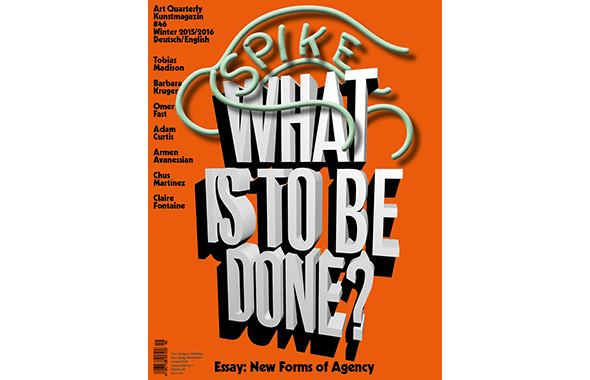Issue 46
What is to be done?
spikeartmagazine.com
Get issue 46 or subscribe
Facebook / Instagram / Newsletter
Since the human is no longer central to history—replaced instead by networks and systems—the old question “What is to be done?” needs to be reconsidered. What forms of organisation still allow artists to create their own worlds? What does it mean to be political today? What possibilities for action remain, and which ones are opening up?
In his essay “New Forms of Agency,” Lars Bang Larsen finds new, fluid ways to act that go beyond the false choice between accelerating or dropping out.
What do we look for in art, now that art-making has become so career-oriented? In exceptionally frank discussions about one’s own embeddedness in an increasingly severe art system, artist Constant Dullaart and curator Toke Lykkeberg discuss the effects of start-up culture and the rematerialisation of the art object. Fulvia Carnevale of Claire Fontaine and theoretician Rory Rowan ask what hope is left when there is too little time for thinking, when artists have to act like rock stars to please collectors, and any radical suggestion is seen as an attack.
Curator Chus Martínez imagines an art world that is like a human pyramid: inventive and weird; always reaching for the unseen. Theoretician Jack Halberstam reminds us what we can learn from the ways children explore the world. Artist Trevor Paglen looks at options for evading total surveillance, and artist Patrick Staff thinks about how to define subjectivity and temporality in new, queer ways.
In our “Portrait” section, Alexander Scrimgeour explores the work of Berlin-based Omer Fast, whose perfectly crafted, deeply unsettling videos turn filmic illusion against itself. Erika Landström casts a fresh gaze on the iconic works of Barbara Kruger and their underlying ambivalence towards action and autonomy. Barbara Casavecchia tries to pin down Swiss artist Tobias Madison’s practice, which shuffles between refusal and participation, withdrawal and exposure, community spirit and calculated outsourcing. And artist Andreas Reiter Raabe speaks with Oswald Oberhuber, one of the most influential figures of Austrian postwar art, who stands as an example for the artist as generalist.
The Artist Placement Group, who brought artists into UK factories in the 1960s, stand for a hands-on engagement of artists with societal infrastructure. Gil Leung sits down with co-founder Barbara Steveni to discuss APG’s history and what can be learned from it today.
How can theory be effective in the world? Timo Feldhaus talks to philosopher Armen Avanessian, advocate of Accelerationism and Speculative Realism, about why he prefers the art world over the academy, and how to bring the Left up to speed with financial capitalism.
What will be the role of the architect in the light of the refugee crisis? Architecture critic Niklas Maak drafts a pragmatic utopia. And artist Liam Gillick watches Bitter Lake, the latest documentary by Adam Curtis, “Maybe the most important documentary maker of our time.”
Christian Falsnaes presents some work of artist pals he favours. Helena Papadopoulos sends a postcard from a busy day in Athens. Curator Defne Ayas writes on how Dominique Gonzalez-Foerster and Ari Benjamin Meyers’s performance K.62 turned out a yardstick for her own practice. And for our column “The End is Night,” American poet Matthew Dickman sends a sad, desperate letter.
Our survey of the most important recent shows from around the world includes Martin Herbert on Berlin’s late autumn exhibitions (featuring Rum, sodomy, and the lash at Eden Eden and surveys of curator René Block’s life achievements); Kolja Reichert spoke to the curators of The Beast is the Sovereign at WKV in Stuttgart; Oliver Basciano strolled through London and saw shows by Jumana Manna, Jon Rafman, Rob Pruitt and Goya; Jennifer Krasinski found some many highlights (and flops) in New York, was stunned by Martin Wong’s first retrospective at the Bronx Museum, and en passant explores the possibilities of image-based art criticism. Elise Lammer saw Maryam Jafri and Martin Creed in Switzerland, while Max Henry got nostalgic at Peter Pakesch’s gallery archive of Ballgasse 6 in Vienna.
Plus: image contributions by Richard Hawkins, Gardar Eide Einarsson, Carola Dertnig, Tala Madani, and Guan Xiao
Spike wishes you a happy and fulfilling 2016.

